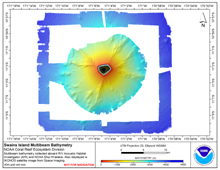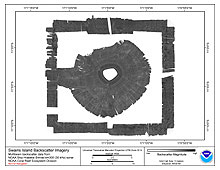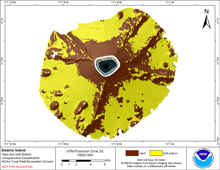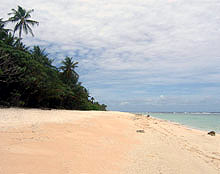[ Bathymetry | Backscatter | Optical Validation | Geomorphology ]
|
3D Visualization of Swains Island seamount. (Click on it to open a larger version.) |
Swains Island is the northernmost island of the U.S. Territory of American Samoa. Situated approximately 320 km north of the Samoan hot spot track, it is geologically part of the Tokelau volcanic chain. It is about 2.4 km long with a lake of brackish water that is cut off from the ocean.
Although part of the U.S. Territory of American Samoa, the island is privately owned. The first European discoverer of the island was Pedro Fernandez de Quiros, who landed there in 1606, naming it de Quiros’ Island. It was unvisited by Europeans until 1840 when Captain W.C. Swains of New Bedford, Massachusetts visited the island thinking he was the first to land on the island and named it Swain’s Island. However, a British captain, Capt. Turnbull, who also claimed to have discovered the island, sold Swains Island to an American, Eli Hutchinson Jennings Sr. In 1956 he and his Samoan wife moved to the island, claiming it with an American Flag.
Click thumbnail maps below to explore PIBHMC’s data sets.
Bathymetry |
Backscatter |
Optical Validation
Not yet available
|
Geomorphology
|
|
The beach on Swains Island. |
The oldest of his six children, Eli Hutchinson Jennings Jr., inherited the island and managed the estate and its copra plantation (copra is the dried meat of the coconut, used as food and for extracting coconut oil). His son, Alexander Hutchinson Jennings inherited the island, and his daughter inherited the estate. Finally, in 1925, Swains Island was formally made part of American Samoa by the US Secretary of State and Alexander Jennings was given official personal rights to the island. Currently, the island is inhabited by 4 to 30 people at a time in order to retain private ownership by the Jennings family and as part of the Territory of American Samoa. It is still covered by a circle of coconut trees; however, it is not run as an active plantation. The 2006 multibeam surveys reveal the absence of shallow banks outside the reef and steep slopes that descend to oceanic depths less than one km offshore.
Learn more abouot the history of Swains Island via the US Department of Interior, Office of Insular Affairs.




